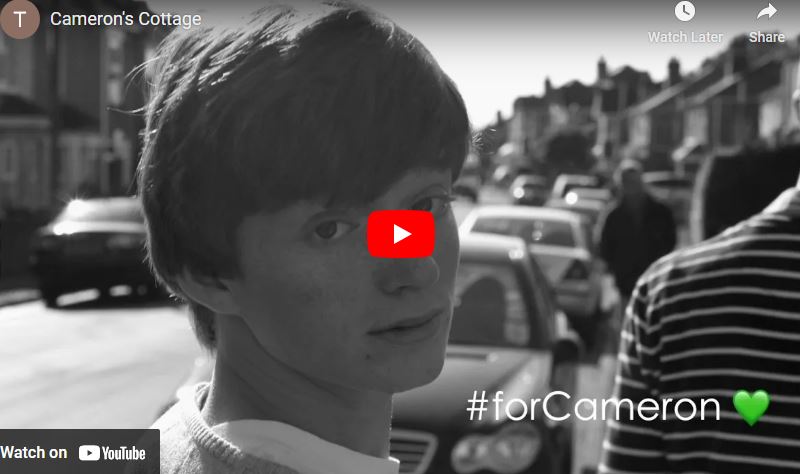
Cameron's Cottage
In partnership with the RSPB in the New Forest
Cameron's Cottage is a non-profit venture in memory of Cameron to make nature more accessible to young people.
We were delighted to partner with RSPB to renovate a derelict cottage deep in the middle of RSPB’s Franchises Lodge reserve in the New Forest, Wiltshire, to create this unique residential educational facility. Cameron’s Cottage will provide a base from which small groups of young people will be able to have exceptional, immersive experiences in nature with wildlife activities being provided by the RSPB.
Now that Cameron’s Cottage is open, we work with youth groups, schools and other organisations to financially support them to bring young people to spend time in nature who would not have the financial means to do so. Please get in touch if this applies to your organisation: info@cameronbespolka.com
Booking Cameron's Cottage
For more information about booking Cameron's Cottage including pricing and availability please email the RSPB: cameronscottage@rspb.org.uk
The Cottage can accommodate up to 19 people, including leaders in 5 bedrooms. Additional discounts are available for groups who meet certain financial requirements.
Activities include:
- nature: bioblitz, bat detecting moth trapping, wildlife walk
- team building: slacklining, blind fold trail, team all maze, wild art
- survival skills: outdoor cooking, kelly kettles, shelter building, pioneering, navigation
Latest news:
New Year at Cameron’s Cottage
21 February 2025
Hello again!
I’m Laura, I work for the RSPB and I run Cameron’s Cottage. I started working here last year and in the Autumn decided to write a seasonal update of all of my goings-on. This is edition 2, Winter!
The Cottage Chronicles will be a seasonal update, written by me, of what we’ve been up to at Cameron’s Cottage. I’ll try to include the highlights, some stories from recent groups and my general musings of what the last few months have been like.
Although sunny outside today as I write this, it has been a cold, windy and rainy few months since I wrote the last blog. Cameron’s Cottage doesn’t host many groups of young people over the Winter, so it’s been strange to see the Cottage so quiet after a full-on summer! But that doesn’t mean I haven’t been busy. With less of my time spent on planning bespoke activities for groups and delivering sessions, I can bring my focus to improving current systems and devising new plans for an improved 2025 season. In addition to many other things, I have worked on finding new volunteers to help out at Cameron’s Cottage, started planning for a sensory trail around the woodlands of Cameron’s Cottage and begun research for an interpretation wall inside the Cottage to display information around how the renewable energy powers the cottage.
My other important task this season has been to create and implement a new marketing strategy, to encourage new and repeat bookings to the cottage. This has been in the form of creating a new promotional leaflet, contacting local group leaders and organisations, visiting local careers and volunteer fairs and working with other RSPB colleagues internally for a range of media and press opportunities. Keep an eye out for a Cameron’s Cottage social media page, hopefully coming soon!
I have worked on finding new volunteers to help out at Cameron’s Cottage, started planning for a sensory trail around the woodlands and begun research for an interpretation wall
And the hard work is starting to pay off, new bookings and return visits are trickling in as the calendar starts filling up for March onwards.
A definite highlight for me over these winter months was an unexpected snow flurry, turning Cameron’s Cottage into a scene from a Christmas Card! I was totally unprepared, having left my coat behind, but being caught out in the snow was a small price to pay for a magical memory and some fabulous photos.
Now the days are getting longer, and the first signs of Spring are appearing, I look ahead to the first of this year’s groups visiting Cameron’s Cottage and making lasting memories in nature.
If you, or anyone you know might be interested in volunteering with us or booking a stay at Cameron’s Cottage, do use the links below for more information.
Volunteering: https://bit.ly/cameronscottagevolunteering
Booking a stay: https://bit.ly/cameronscottage
Until next time,
Laura
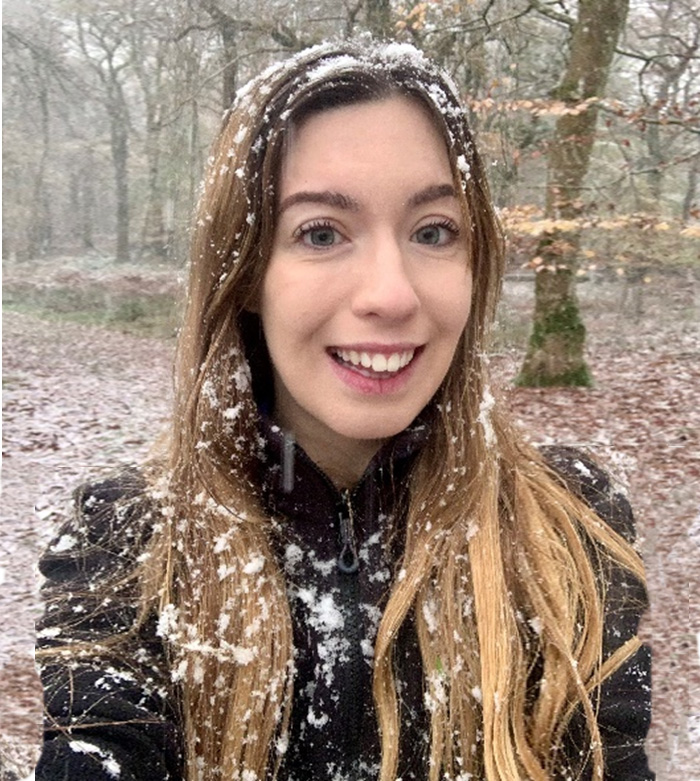
Laura enjoying the snow at Cameron's Cottage
Cameron's Cottage Residential from Leaside Trust
13 December 2024
Please read this excellent blog from Leaside Trust in Hackney after their visit in October.
It’s always such a pleasure to fund groups of young people from London so that they can experience a residential trip to the countryside and Cameron’s Cottage in the RSPB reserve, is a wonderful place for them to spend some time in nature.
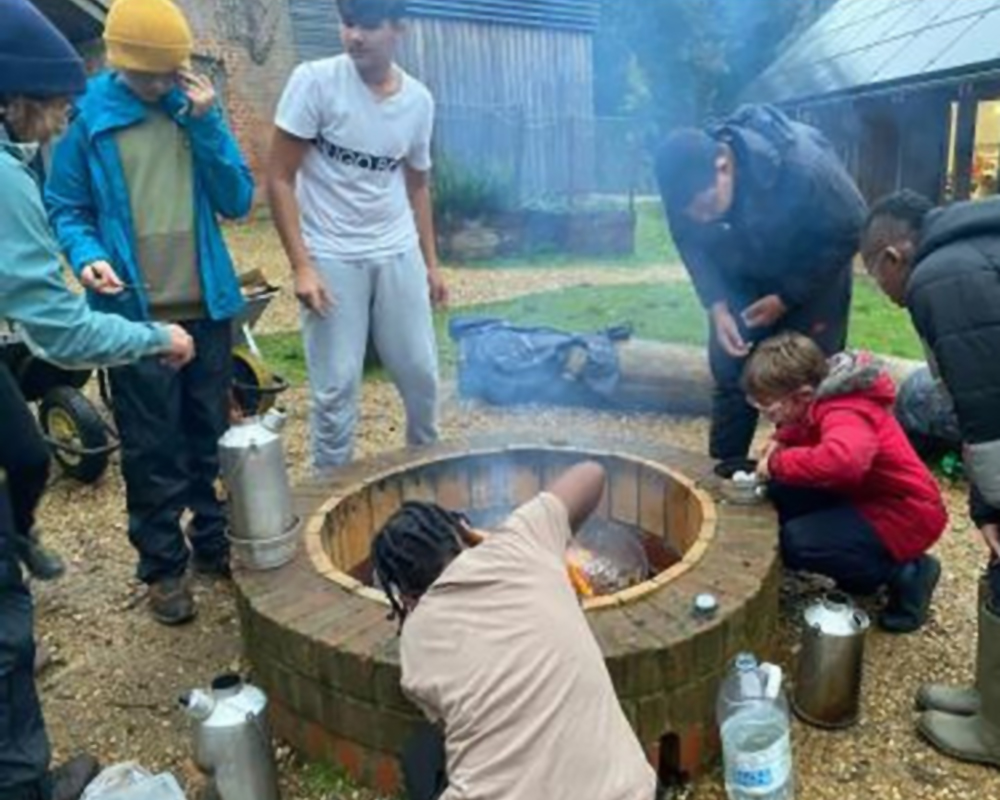
Leaside Returns for another New Forest Adventure
New Beginnings at Cameron’s Cottage
19 November 2024
Hello everyone!
For those who don’t know me, I’m Laura, I work for the RSPB and I run Cameron’s Cottage. I started working here in June and it’s been a busy few months since then!
The Cottage Chronicles will be a seasonal update, written by me, of what we’ve been up to at Cameron’s Cottage. I’ll try to include the highlights, some stories from recent groups and my general musings of what the last few months have been like.
It’s looking very autumnal outside as I write this; and I love using nature to reflect on the recent times gone by. Summer is a busy time for all, Cameron’s Cottage included, but Autumn sees a quieter pace of life, a sense that nature is winding down, ready for Winter. Like the trees losing the last of their leaves, the Cottage has seen the last of its residential visitors for the year. But that doesn’t mean there’s not work to be done! Like busy squirrels, the Cameron’s Cottage Team are gearing up to use this quieter season to plant some metaphorical acorns - planning and preparing for next year.
Since I started at the end of June there have been 24 visits to Cameron’s Cottage, some part-week or full-week residentials and some day visits. That’s more than one group per week! Like I say, it’s been busy!
We’ve made natural shelters, whittled mallets, discovered wildlife, explored nature by night, brainstormed conservation issues, forest-bathed, partook in teambuilding challenges, cooked on the open fire, written nature poems, designed nature art and so much more.
It’s hard to pick one highlight, my role is incredibly rewarding – I love seeing young people coming out of their shell through the medium of nature. We teach them about conservation and wildlife, but what they take away is so much more than that, it’s a confidence in who they are, a strengthening of team building skills, an appreciation of conservation work and a new-found understanding of how nature improves our wellbeing. I find, for urban groups, this is most prominent. For some individuals this has been their first time in a woodland.
“As an inner-city youth organisation, a key goal is to enable young people to get out into more natural environments. It’s fantastic to be ‘off-grid’ and for the young people to learn so many new skills in a largely outdoor environment. Many of our group have never been in a forest type environment so it was helpful they learnt more about the area and how to respect the environment.”
A stay at Cameron’s Cottage is so much more than a visit to a nature reserve, it’s a time of firsts and of new beginnings for so many – myself included! It’s a blessing to watch so many young people take part in these ‘nature firsts’. Whether that’s their first time in a woodland or developing a desire to pursue a conservation career, this is how I know Cameron’s Cottage is quietly changing lives.
To sum up just how much fun we’ve had, let’s hear one young person’s take-away:
“One of the best weekends of my summer.”
Let’s hope there’s many more ‘best weekends ever’ to come!
Until next time,
Laura
New Members for the RSPB Management Team
07 October 2024
We are delighted to welcome to new members to the RSPB's management team, Visitor Engagement Officer, Linda Ronald and Learning Officer, Laura Pringle.
We will let them introduce themselves:
Linda: Hi, my name’s Linda, and I’m the Visitor Engagement Officer at Cameron’s Cottage. My background is mostly in support work and welfare within the education system, from primary schools to sixth form colleges, and I began volunteering with the RSPB as a residential volunteer for five months at the RSPB Old Moor reserve in South Yorkshire at the start of this year. What a fantastic change of direction! I’ve always loved being out in nature, and have learned so much more this year through the RSPB. The more I learn, the more fascinated I am by the wildlife and habitats around us, and the more passionate I feel about protecting and promoting our natural world. I’m loving being part of the Cameron’s Cottage team and welcoming guests to this unique and peaceful space. It’s a privilege to lead sessions where young people can enjoy being active, exploring nature and experiencing the beauty and calm of the forest.
Laura: I am excited to have joined the team as Learning Officer for Cameron’s Cottage in June this year. I have been with the RSPB for 5 years, firstly as a volunteer then in as an employee working in a couple of different visitor facing roles since early 2020. I have spent the last 3 and a half years working for the RSPB in Dorset, with a large part of my time spent at Arne Nature Reserve. I enjoyed leading guided walks and family activities and doing all the behind the scenes planning this needed, but my favourite part of my role was definitely organising and delivering sessions to school groups visiting the reserve. Creating a space where children and young people could learn and begin to care for nature was the highlight of my role. Which is why I’m so excited to now be working at Cameron’s Cottage. This team has created an amazing facility and I can’t wait to continue to build on this work and grow Cameron’s Cottage and its ability to capture the hearts and minds of thousands of young people! I look forward to working with many of you and want to thank those of you I’ve already met for your warm welcome.
Young Writers Camp
07 October 2024
‘An absolutely fantastic, inspiring and overwhelmingly hopeful weekend’ – as put by one of our attendees, the first ever camp for Young Nature Writers at Cameron’s Cottage was very special. It was such an honour to create a space for young people with an interest in nature and writing to forge friendships with like-minded individuals, learn from experts and have time to write in the beautiful New Forest.
Hosted by Emily Hunt and Andrew Millham, and kindly supported by Alasdair Robertson from Cameron Bespolka Trust, the weekend was a unique experience and enjoyed by all. The aim of the camp was to provide young people with the opportunity to connect with nature, connect with each other and enter a space where they can focus on writing and nature.
Here is what we got up to during the weekend:
Friday
Once everyone had arrived, we kicked off with some brief introductions and an icebreaker game – guess the animal/plant on your head… This proved to be more difficult than anticipated! Everyone settled in quickly.
For our first session, we welcomed Roger for his talk on nature writing and his experiences in the field. It was interesting to hear Roger’s unique perspective, and everyone thoroughly enjoyed his talk. This was an excellent opening to the weekend!
We then ventured out on a short walk and set up our moth traps for the next morning.
Following a lovely meal, we launched into our Open Mic session. The group assembled around the campfire, and Emily, Andrew, Stephen Moss and Roger Morgan-Grenville all gave readings, along with many of the attendees. This was one of the highlights of the weekend. A special mention goes to attendee Finn who recited The Trees by Phillip Larkin from memory!
We were also treated to some wonderful music from Andrew on his Irish bouzouki while we toasted marshmallows.
Saturday
On Saturday we were all up bright and early and ready for the day! However, we were met with an onslaught of rain – which caused some rescheduling, and thankfully cleared up in the afternoon!
First of all, we unboxed the moth traps, led by attendee Max who has an incredible knowledge of insects. Max guided us through the different species, and we had a great selection considering the weather. Then, with our table adorned with moths, Emily and Andrew led some moth-related writing activities, including turning a basic description into a poem and zooming in on specific parts of moth anatomy.
We then took part in a fantastic Writing in the Field session led by Stephen Moss. Due to the rain, we didn’t actually write ‘in the field’, but instead wrote about an experience in nature from our childhood. Afterwards, many attendees shared their work, and it was very impressive to hear what they had created in just an hour or so!
Thankfully, the rain stopped, and we were able to venture off into the woods for our roaming workshop. This consisted of three activities – a mindfulness activity from Andrew, writing from the perspective of a woodland species from Emily, and an activity from our guest Jeni Bell, comparing positive and negative experiences in nature. Being in the woods, it was inevitable that we were going to get distracted by wildlife while doing these activities… perhaps the most notable was Stephen’s firecrest sighting!
We then headed back to the cottage for Jeni’s session on confidence and empowerment in writing. Jeni spoke about finding your voice and overcoming barriers that may stop us from writing. The messages given in Jeni’s talk were very important, and it was a delight to be joined by Jeni for the day – the group loved Jeni’s enthusiasm and really connected with her sessions.
We then had a brief interlude between sessions, during which we lit the campfire and were serenaded by Alasdair on his low whistle.
In the evening, we were joined by Lucy Houliston, who gave a fascinating talk about bats. We learnt all about UK bat species, in preparation for our nighttime bat walk. Lucy also talked about the elements of her career that have involved writing, showing how she has used her writing skills throughout her jobs with charities and NGOs.
The bat walk on Saturday evening was a definite highlight of the weekend – picture a group of teenagers trekking out across the heathland in the dark! The bats put on a bit of a show, treating us to a fantastic view of a soprano catching a moth right in front of us. This was a wonderful end to the day.
‘The biggest thing this weekend has shown me is how much I want to learn, but it’s also confirmed that whatever I do, I want to work with people like the ones I met this weekend.’
Sunday
Thankfully, when we woke up on Sunday it was not a torrential downpour! We kicked the day off with a nature walk and bioblitz activity run by Emily and Andrew.
The bioblitz involved setting off in pairs and finding as many species as possible in half an hour, using the equipment chosen from the cottage – pond dipping kits, insect catching nets, etc. Embarrassingly, Emily and Andrew did not win… instead the winners were Rufus and Freddie, with a very impressive number of species!
We then headed back to the cottage for a talk and Q & A with Stephen Moss. This was packed full of interesting insights, and in particular explored Stephen’s incredible career.
Stephen’s talk was followed by Dominic Couzens. Dominic really captured the attention of the group, putting a smile on everyone’s faces. He gave some brilliant tips and advice to bring the weekend to a close, and a valuable insight into life as a writer.
Thank-yous
It was such a privilege to be joined by such amazing writers and speakers at the camp.
A special mention must go to Stephen, who generously joined us for the whole weekend. Being the incredible speaker and guide that he is, Stephen engaged and educated the group on many different topics. Meeting Stephen was an amazing opportunity, all of us hugely valued his company.
Thank you to Stephen, Roger, Jeni, Dominic and also Alicia Hayden who provided us with a recorded poetry activity.
Thank you to the Cameron Bespolka Trust for supporting and funding the camp - Corinne, Alasdair and Sienna. It obviously couldn’t have happened without them!
Thank you also to Andrew (Emily is writing this blog!), who helped Emily to organise and host the camp.
Comments
Below are some comments lifted from attendees’ reviews of the weekend.
- ‘This was one of the best weekends of my summer.’
- ‘The spirit of community and connections that the camp created was wonderful – not only between us, meeting so many other like-minded young people whilst receiving invaluable advice from established writers, but also allowing us to really connect to nature and our own writing through the fantastic writing activities, workshops, walks and talks. In short, an absolutely fantastic, inspiring and overwhelmingly hopeful weekend.’
- ‘The biggest thing this weekend has shown me is how much I want to learn, but it’s also confirmed that whatever I do, I want to work with people like the ones I met this weekend.’
- ‘I have really really enjoyed the weekend. You have created something so special here. I especially liked meeting other young people that read books, love nature and are generally lovely people! Thank you so much Emily and Andrew!’
- ‘I would list my favourite parts except I think it would just result in me rewriting out the itinerary.’
- ‘I’ve got so many new ideas and most importantly feel a lot more confident and validated in my writing ability’
- ‘Thank you so much for all the effort you put in to organising this weekend! It’s been really lovely to meet you both as well as so many other like-minded people, and have the opportunity to spend some time in nature.’
- ‘I really loved the guest speakers and have learnt a lot; it's been a unique opportunity to get to know experienced writers like Stephen, and really reassuring to see how kind and enthusiastic they were.’
- ‘Immersed in the New Forest, I couldn’t have imagined the creative flow that was stimulated by the youthful team and wisdom of our guests.’
Open Days
We would love you to come and visit Cameron’s Cottage and see for yourself. If you are a school, college, university or an organisation who is thinking of taking a group of young people for a day or overnight stay, please email date you can join us to: cameronscottage@rspb.org.uk
Cameron's Legacy
To celebrate the official opening week at Cameron’s Cottage, we are very proud to share this video which shows the result of many years of collaboration between the Trust and the RSPB.
2 Minute Introduction to Cameron's Cottage:
solar powered and low-impact
Cameron’s Cottage offers an immersive outdoor experience for 15 – 25 year olds in a stunning woodland packed full of wildlife, including many rarities.
Whether it’s getting creative through outdoor cooking and wild art, tackling the grittier side of nature with survival skills and conducting research or learning conservation skills, those coming to stay at Cameron’s Cottage will have the experience of a lifetime.
Franchises Lodge is a haven for wildlife, from birds of prey to unusual fungi, orchids and loads more. In this idyllic setting, young people can come together to take part in activities ranging from shelter building to conservation skills, plus much, much more.
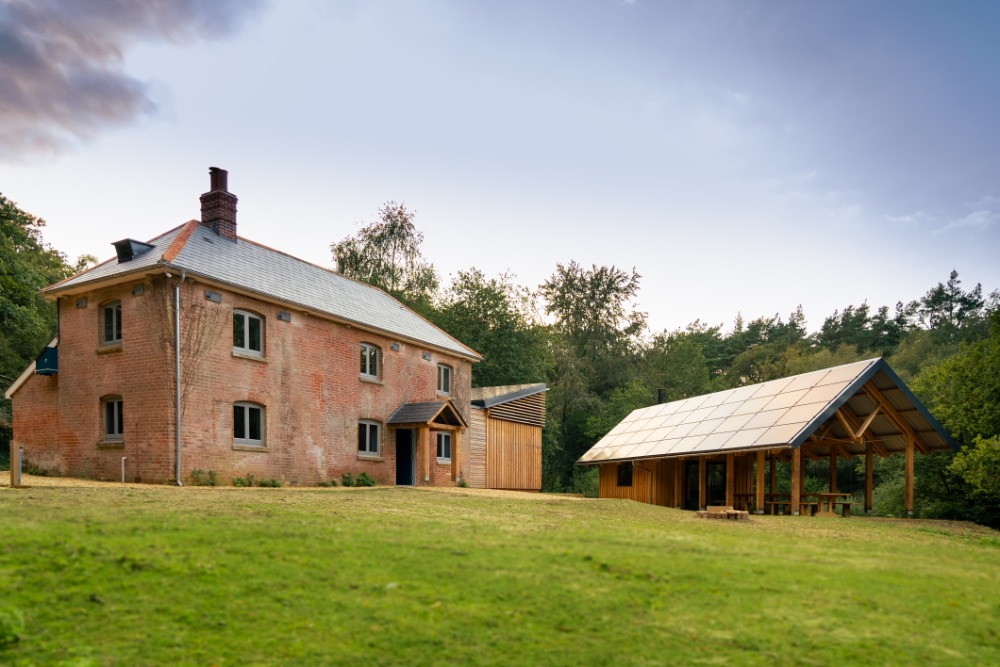
The newly refurhbished Cameron's Cottage will be a wonderful base fromm which to be immersed in nature
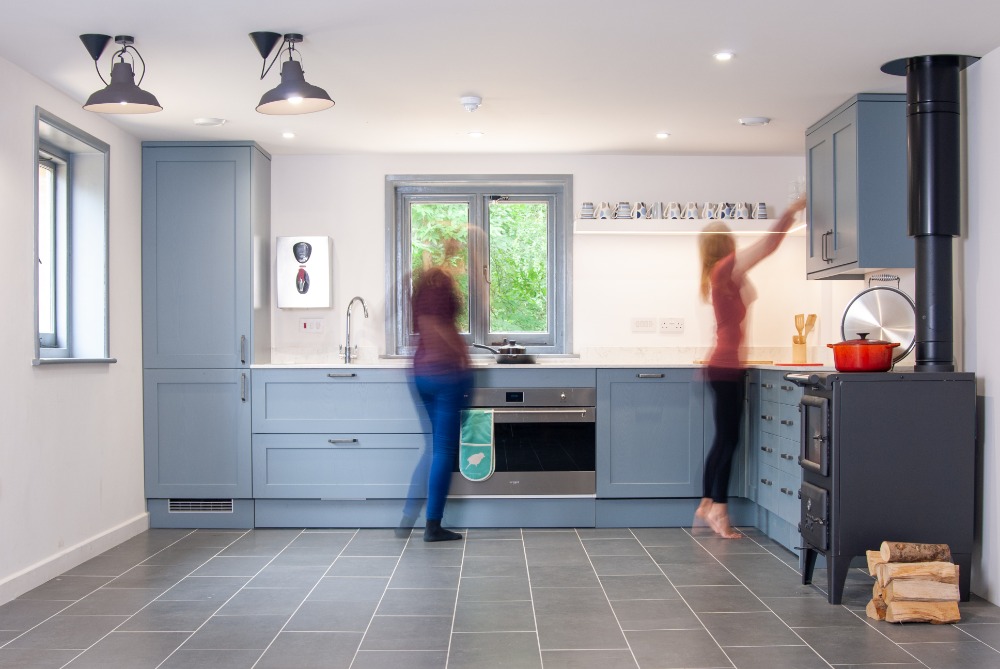
The fully-equipped kitchen

The living area where many stories will be shared
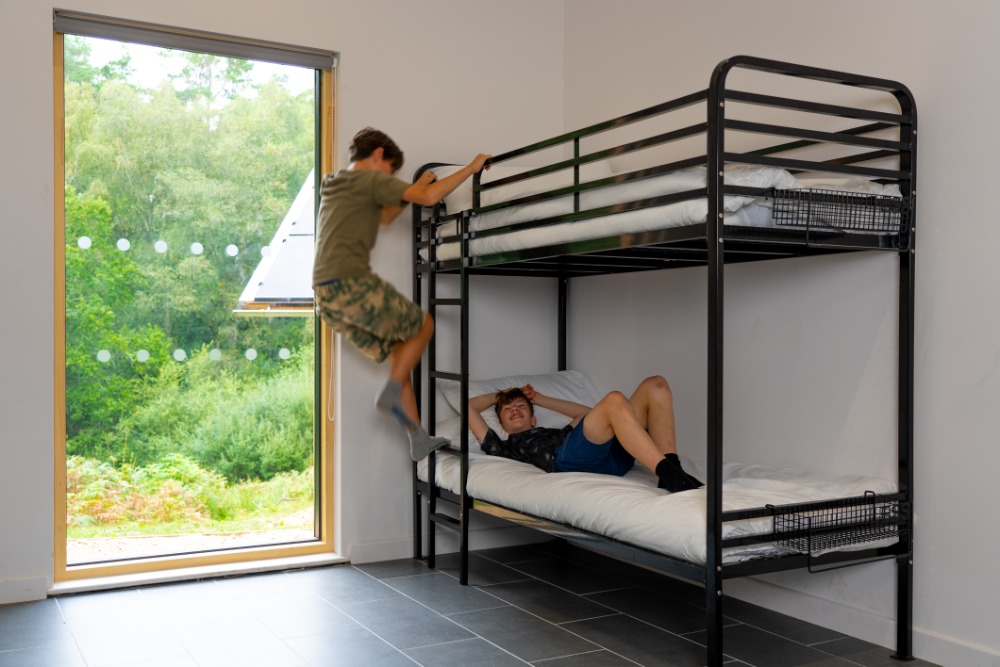
Bunk room with a view - nature is right on your doorsteps
Outdoor Classroom
Next to Cameron’s Cottage there is an open-sided wooden outdoor classroom which can be booked for day visits from schools. These day trips will include nature activities provided and led by RSPB.
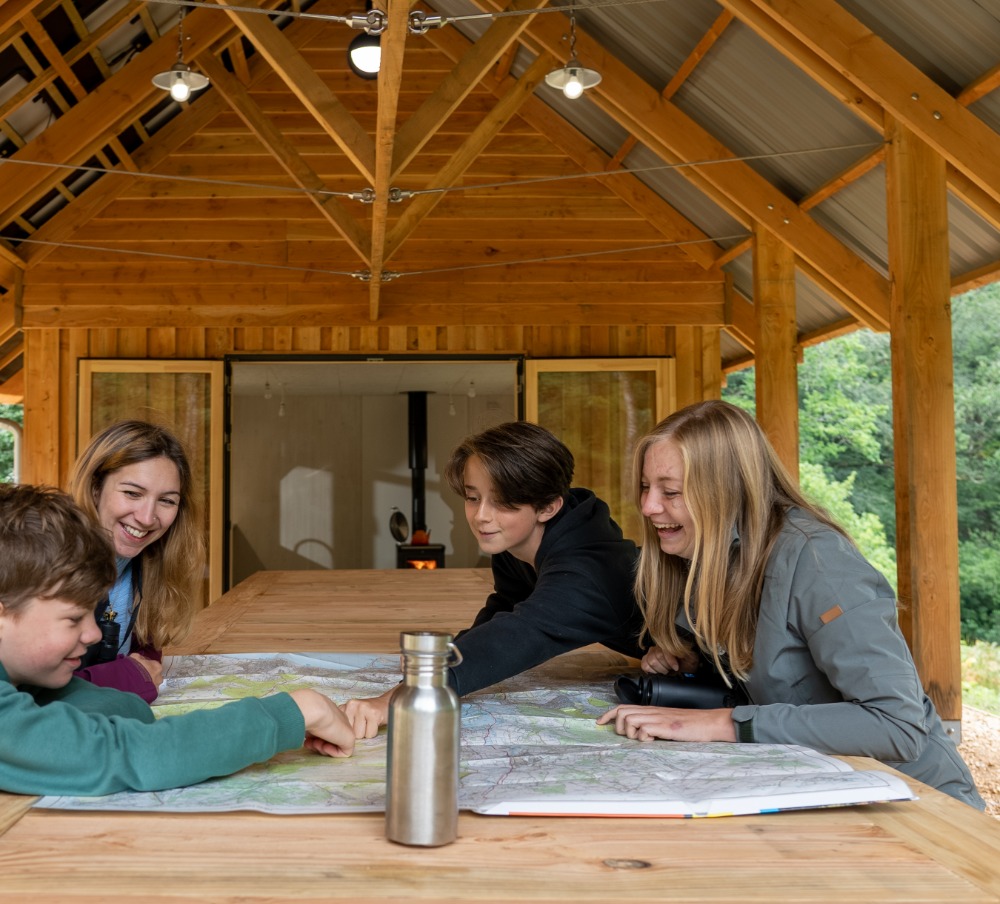
The outdoor classroom will bring the guests closer to nature
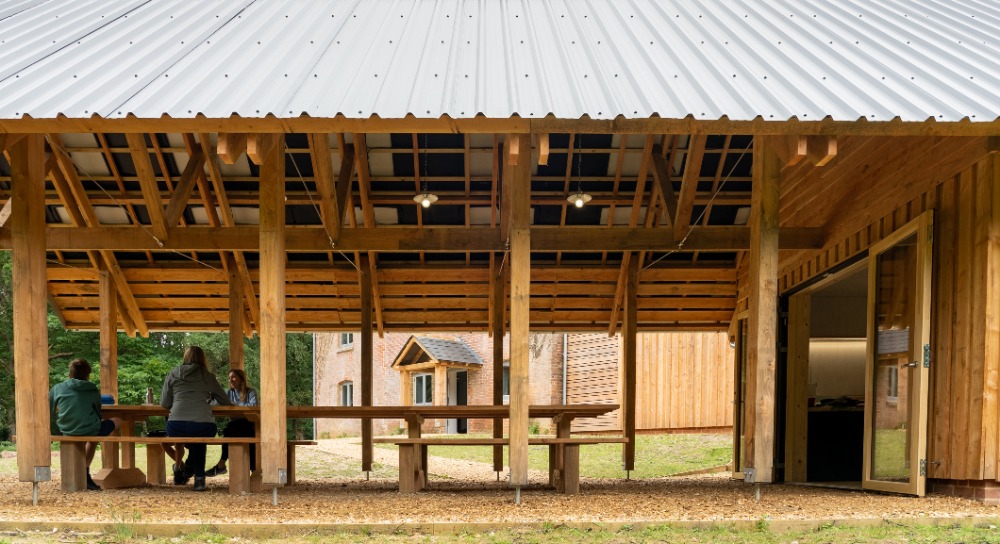
"Cameron’s Cottage is completely off-grid with heating and electricity provided by solar power, so it really is the ultimate nature experience"
Sustainability
We are proud of the fact that Cameron’s Cottage is off-grid, relies on solar power and is wildlife friendly. All the timber used to renovate the Cottage has come from the site. The douglas fir trees needed to be thinned by a third to allow light to reach the ground and to increase biodiversity. Solar panels are located on the study centre and extension roof producing 10KW power per hour with battery storage.Groups can monitor their power use and adapt according to the amount being generated or stored. This is a fantastic learning resource for how we need to think carefully and consider the impacts of how we use resources. A firepit and equipment has been provided to encourage outdoor living.
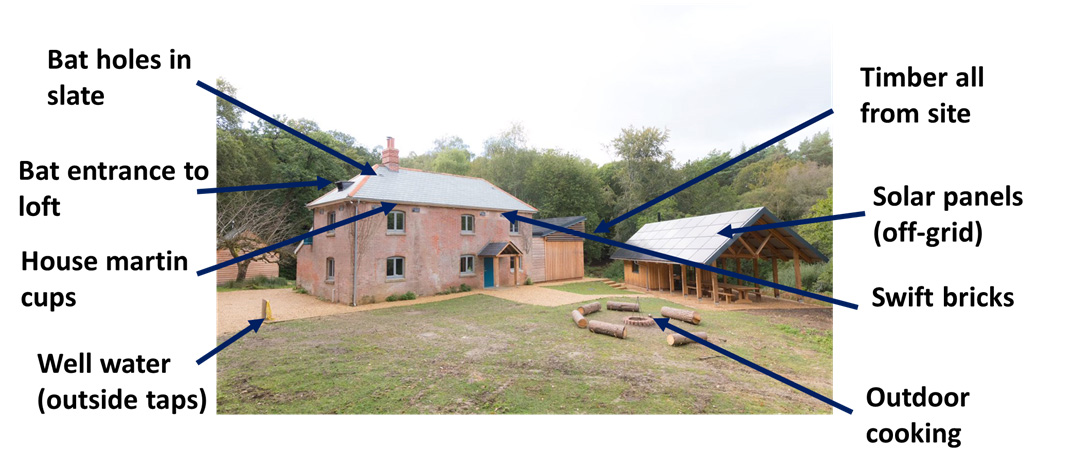
The water is heated by solar heating in the warmer months but switches to solar power for the winter. Inside, all appliances have been planned to have a low energy use. There are wood burners inside the kitchen and study centre to provide additional heat but can also be used to cook indoors and has an additional hob. A heat source pump supports the low carbon heating arrangement by drawing heat from the outside air and transferring to the underfloor heating system to warm the building.
Outside, wildlife friendly features have been built into the design including swift bricks, house martin cups, greater horseshoe bat entrance and bat entrances included in the roof slates. There is an old well which supplies water to outside taps to wash boots, whilst inside the water does come from a mains supply. The property has its own sewage treatment plant to treat sewage safely and with no negative impact on the environment. This is fenced in the garden and will eventually be hidden by a native hedge that will provide a nectar source for butterflies, moths and bees to support the ecosystem.
To find out more about how sustainable and environmentally friendly this Cottage is, please have a listen to Joe Moorhouse, the Architect who worked on the whole renovation project. He explains the care and attention taken to make sure this off-grid Cottage is low-impact as well as being a home for lots of wildlife all around.
The video from Moorhouse Architecture shows the work that went into transforming the derelict cottage
Generous Support
Thank you to Garfield Weston and the National Lottery Heritage fund for their generous support.

Cameron's Cottage
Read all about how we came to be partnering with the RSPB to create this wonderful retreat and learning centre deep in the New Forest.

Videos
2 Minute Introduction to Cameron's Cottage:
solar powered and low-impact
The video from Moorhouse Architecture shows the work that went into transforming the derelict cottage












